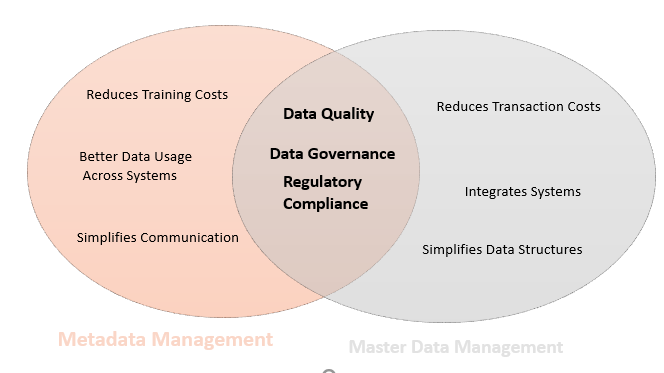
Businesses rely on knowing their data to survive and grow. Metadata management and master data management (MDM) provide essential processes for organizations to gain this knowledge and succeed. As a result, both need to be managed well. However, the differences and intersections between metadata management vs. master data management are often complicated to disentangle for many enterprises seeking to better leverage and govern their extensive data assets.
Bad metadata management leads to higher expenses and lost opportunities. For example, on September 23, 1999, NASA lost the $125 million Mars Climate Orbiter after a 286-day journey to Mars, due to a metadata inconsistency.
MDM is essential for customers to have a successful experience. Donna Burbank emphasizes its business value:
“Master Data Management (MDM) can help build a 360 degree view of key business information to allow you to take full advantage of your organization’s data for better business outcomes.”
Clearly, attention to metadata management and MDM translates into reduced costs and increased business efficiency.
The famous ancient Greek philosopher Aristotle once said:
“In all disciplines in which there is systematic knowledge of things with principles, causes, or elements, it arises from a grasp of those: We think we have knowledge of a thing when we have found its primary causes and principles, and followed it back to its elements.”
Metadata management and MDM work to aid in defining the primary problems (or efficient causes) and tracing that back through the data elements to achieve the desired results. While the same data elements or business drivers (e.g., customer phone numbers, sales receipts, transaction reports) may be used in both metadata management and MDM, the systematic approach is different.
Specific case studies provide a window into how metadata management vs. MDM approaches have solved business problems and led to desired results (the final cause). However, understanding metadata management and MDM frameworks can also prescribe how companies can achieve their business objectives.
Metadata Management vs. Master Data Management: An Overview
Metadata is information about the data collected: the what, where, why, when, and how. Think of it as a wrapper around data that describes it, like how packaging tells you what food is in a box or a container. Essentially, it helps an organization understand its data.
Over time, “consistently applied metadata will yield greater and greater returns, while lack of such Metadata will progressively compound retrieval issues and further stress organizational efficacy.” According to the Data Management Body of Knowledge (DMBoK), key considerations of metadata management include:
- Metadata capture and storage
- Metadata integration and publication
- Metadata management and governance
Master data represents the consistent and uniform conceptual elements that make up a business. This includes transactions, references, and activities. It comprises whatever an organization does and how it is defined differently across business units and from competitors. MDM entails control over master data values and identifiers, enabling consistent use, across systems, of the most accurate and timely data.
The Overlap Between Metadata and Master Data Management

Metadata management and master data management share some common end results through their activities and business drivers as well. Particularly, both improve:
- Data Quality: Metadata Management results in the organizational understanding of business terms and uses, increasing the confidence in the organization’s data and preventing out-of-date or incorrect usage of that data. Through metadata management activities such as metadata stitching and tracing the data lineage, better Data Quality results because the right data becomes connected correctly. Master data management provides platforms to enhance Data Quality. For example, Amurta’s Master Data Management platform enabled a leading retail customer to improve their Data Quality by cleansing the data and eliminating duplicate records.
- Data Governance: Organizations need to control data assets through Data Governance, a collection of practices and processes. Both metadata and master data are included in a company’s data resource. Good management of each requires integrating any metadata management into the larger Data Governance structure and implementing Data Governance into a master data management solution. Each of these Data Management strategies assures a company’s ability to master and manipulate its data.
- Regulatory Compliance: Metadata management requires creating a data lineage to get an accurate understanding of the organization’s data. As a side benefit, metadata management produces an audit trail for compliance. Master data management solutions, such as Reltio, simplify compliance by providing a single point of reference to understand where regulated data exists within the organization.
Contrasting Metadata Management vs. Master Data Management
Metadata management and MDM differ in outcomes such as the following:
- Reduced Training vs. Transaction Costs: Metadata management improves communication. For example, metadata management may lead to producing a business glossary to document and store organizational business concepts and terminology. Since this process provides a common vocabulary, it becomes easier to train employees and customers, as the language is the same. Team members understand what is meant by the term “customer” before developing and testing a product instead of after their work is done. In contrast, master data management reduces transaction costs.
- Better Data Usage Across Systems vs. System Integration: Metadata management allows an organization to create a high-level conception or map of its data. As a result, a solution like Data Advantage Group’s MetaCenter Enterprise Metadata Repository product can track what and how information changes across various platforms. Master data management improves interoperability between systems. For example, the Hach company needed to ensure information about water quality testing equipment from over 25,000 digital assets, many printed documents (e.g., catalogs) in more than 20 different languages. By using Stibo Systems’ Master Data Management platform, STEP Trailblazer, Hach was able to publish, update, and maintain all the product information, streamlining it in one place.
- Simplifying Communication Between Data Consumers and IT vs. Simplifying Data Sharing Architectures: Good metadata management requires identifying all external and external metadata sources and what the business is trying to capture. Through metadata integration and publication, IT gains a better understanding of the business requirements – hence, the architecture(s) needed (e.g., how a data warehouse will store the data). Master data management simplifies the architecture around customer transactions. According to Blake Morgan:
“By building a simple centralized repository of customer data provides a centralized view of that customer’s preferences, improving analytics and business transaction experiences.”
Use Cases of Metadata Management and MDM
Metadata Management
As one of the largest employers in Missouri, with 15 hospitals and a comprehensive network of care facilities, BJC Healthcare needed better data for better health care. As Laura Tellmann, the then-director of clinical informatics, noted, this required engaging leadership and team members through Data Governance policies toward improving Data Quality. To support these Data Governance initiatives Tellmann developed a repeatable process around metadata management. She located advocates and trained them in the terminology. As a result, team members were speaking a common language and understood what the health industry and technology called things. This helped define specific frameworks around projects geared toward supporting Data Governance Initiatives.
Master Data Management
Sam Copeland, vice president of global sourcing organization for Office Depot, faced the challenge of how customers shop and how their shopping activities are changing. He wanted Office Depot to respond to the increased demand for a more comprehensive multi-channel shopping experience. Office Depot needed a responsive solution that could standardize data for “a complex web of hundreds of suppliers offering millions of products.” This level of complexity meant finding a centralized master data management solution. Office Depot implemented Stibo Systems’ STEP Solution for Master Data Management. As a result, new product time to market was reduced 60%.
The Importance of Building a Strategy
The metadata management vs. master data management examples above show companies that understood the causes and principles of their business objectives and their desired final outcomes. They certainly all wanted better Data Quality and Data Governance and more control of their data. But, each organization traced back the business elements to a specific metadata strategy or master data management strategy, and as a result, solved a problem. While metadata management and master data management systems overlap, they provide two different frameworks or systems toward solving data problems.
Image at top used under license from Shutterstock.com
